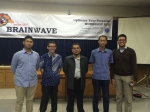Prof. Suprijanto: Multiphysics Approach in Advancing Medical Instrumentation
BANDUNG, itb.ac.id — Prof. Dr. Suprijanto, S.T., M.T., a board member of the Instrumentation and Control Research Group in the Faculty of Industrial Technology at Institut Teknologi Bandung (FIT-ITB), delivered a speech during his scientific conference held on Saturday (August 19, 2023) at the West Hall of ITB's Ganesha Campus.
During the forum, Prof. Suprijanto discussed the main topic of his conference: "Multiphysics Approach in Advancing Medical Instrumentation."
Prof. Suprijanto delved into the history of ITB's Engineering Physics Department, which was established in the 1950s by Prof. Najwin and Prof. Ir. Adhiwijogo. Engineering Physics is a unique amalgamation of physics, electrical and mechanical engineering. It is a multidisciplinary branch that connects physics and its applications in various engineering fields, primarily through a multiphysics approach. This course provides students with knowledge at the forefront of engineering.
Engineering Physics offers a solid foundation in applied physics, particularly in areas like instrumentation and control. The scope of engineering physics is extensive and continually expanding, with the potential to make a significant impact in various industries, including agriculture, transportation, defense, and medical studies.
The central idea Prof. Suprijanto conveyed during his scientific conference is the application of the multiphysics approach to enhance the functionality of medical instrumentation. He explained that medical instrumentation primarily involves the measurement of physical parameters related to organ activities. These physical parameters include bioelectric, bioacoustic, biomechanic, and biooptics modeling.
The source of these physical parameters is typically sensors that convert electrical signals into various graphical formats. Postprocessing and visualization in multiphysics allow the generation of output in the form of printouts, display outputs, or data storage.
Medical instruments and surgical tools play a crucial role in healthcare settings. Traditional instruments like the stethoscope and electrocardiograph (EKG) machine have evolved, enabling us to visualize internal organs without the need for invasive surgery. This involves the use of acoustic or electromagnetic waves that interact with the organ system, generating an electric field to record activities.
Brain activity is a significant focus in medical science, with two primary physical phenomena for brain imaging: electromagnetic physiological signals (EPS) and hemodynamic response signals (HRS). In Indonesia, EEG-based EPS is more commonly used due to its accessibility and lower operational costs.
In 2013, Prof. Suprijanto began his research on EEG-based brain-computer interfaces. This research involved capturing event-related synchronization and event-related desynchronization in motor abilities in the brain using invasive or non-invasive electrodes. It led to the development of a wheelchair robot that uses motion sensors.
Additionally, Prof. Suprijanto explored EEG-based multidisciplinary research related to neuromarketing and the impact of blue light on concentration levels during nighttime driving.
However, his quest for innovation continued, leading him to low-resolution brain electromagnetic tomography, known as LORETA. LORETA combines brain data obtained from a magnetic resonance imaging (MRI) machine and multichannel EEG recordings. This approach requires precision in managing both information systems.
LORETA holds significant potential for expansion, both in medical and non-medical fields. Prof. Suprijanto aspires to apply LORETA principles to monitor changes in medical rehabilitation using a 4D LORETA, particularly in the context of a pneumatic soft robotic glove for hand movement exercises.
In conclusion, Prof. Suprijanto emphasizes that medical instrumentation is advancing with multiphysics and multiscale measurements. This progress broadens our understanding of bio-human system interactions, physical system dynamics, and cyber system connections. He also hopes that the Engineering Physics Department will participate in the accelerator node of the Multidisciplinary Program of Medical and Science Technology at ITB, starting in 2023.
Reporter: Hanan Fadhilah Ramadhani (Civil Engineering 2019)
Translator: Kezia Hosana
Editor: Vera C.U.

scan for download







